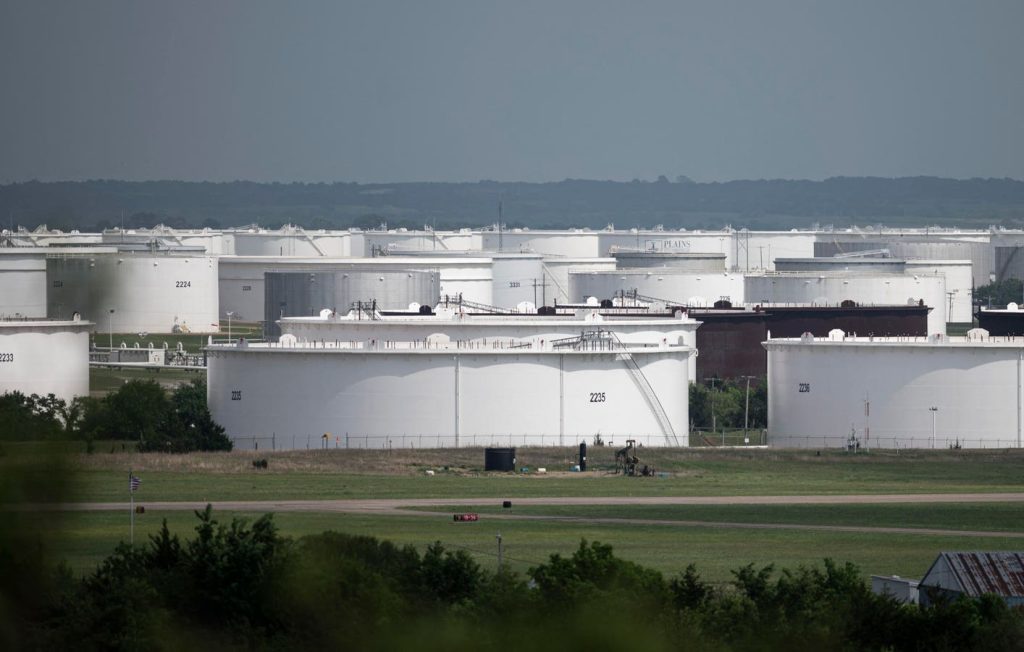A crude oil storage facility in Cushing, Oklahoma, U.S. (Photo: Johannes Eisele)
AFP via Getty Images
Global oil prices remain stable due to increasing crude inventories and OPEC’s decision to enhance oil production.
As of 12:37 PM EDT on Monday, the global benchmark Brent traded at $64.17 per barrel, slipping by $0.10 or 0.14% in Asia. This marks a decline compared to Friday’s close in the U.K. and U.S., both of which were closed for public holidays on Monday.
Similarly, West Texas Intermediate decreased by $0.05 or 0.08% to $61.47 in Asia, showing little change from Friday amidst a market lacking bullish sentiment. Both benchmarks are hovering near four-year lows as experts struggle to revise down their price forecasts for this year and next.
Sharp declines were mitigated after U.S. President Donald Trump postponed tariffs on the European Union, allowing for further trade discussions. This latest development is part of an ongoing situation that started in April, intensifying fears of a global trade war.
Anticipations of even lower oil prices are fueled by U.S.-Iran nuclear negotiations and OPEC+’s resolution to increase output. The latter decision is particularly affecting the market sentiment.
Production Increases and Market Impacts
The market is currently anticipating a potential third consecutive production increase by OPEC+ in July, estimated at around 411,000 barrels per day. Although the producers’ group has not commented yet, they recently agreed to raise oil production for a second month by a similar 411,000 bpd for June.
This previously confirmed June increase will bring the total hikes for April, May, and June to 960,000 bpd, amounting to 44% of the 2.2 million bpd cuts initially agreed upon since 2022. This marks a strategic effort to capture a larger market share at the expense of non-OPEC producers, especially U.S. light sweet crude suppliers.
Challenges in the Market
However, the combination of higher OPEC+ output and the possibility of easing U.S.-Iran tensions isn’t the sole reason for the subdued market sentiment. A volatile macroeconomic landscape and a supply glut exceeding global demand growth, currently estimated at around 1 million bpd, are contributing factors as well.
This situation is being reflected in inventory data. Importantly, the International Energy Agency (IEA) reports that global oil inventories remain elevated. According to their recent assessment, inventories rose for a second month to 7.7 billion barrels in March.
Though this figure is below the five-year average, market sentiment has evidently shifted. The IEA forecasts an average rise in oil inventories of 720,000 bpd this year and 930,000 bpd in 2026. Additionally, a resurgence in the use of floating oil storage is noted, with data from Kpler showing a 14% increase in stored oil aboard tankers for seven days or longer, rising to over 160 million barrels—the highest figure in two years.
Kpler attributes 40% of this floating storage to Iranian crude and 15% to Russian supplies, signaling concerns as offshore storage is typically more expensive and used as a last resort when onshore options dwindle. This points to difficulties for oil producers in selling their products due to oversupply or decreased demand, or both.
These multiple factors clearly indicate a potential for lower oil prices imminently, especially with OPEC+ ramping up efforts to secure greater global market share.
Disclaimer: The above commentary serves to provoke discussion based on the author’s personal analysis and opinion. It should not be regarded as solicitation, recommendation, or investment advice regarding oil stocks, futures, options, or products. Oil markets are notoriously volatile, and opinions in this sector may change rapidly.



